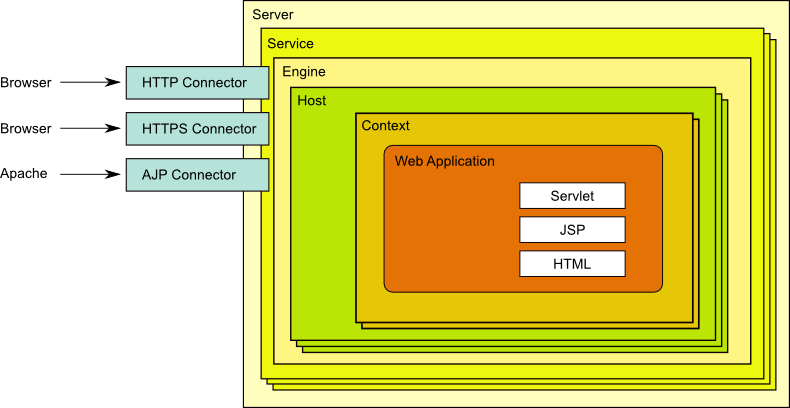

Each service element groups one or more connector components together with a single engine. The Catalina server contains one or more service elements. Tomcat uses the Jasper engine to convert JSP files into servlets, which are rendered into HTML pages for clients. The Catalina server represents the Tomcat architecture in its entirety, and provides an environment for running servlets. The two top-level elements of Tomcat are the Catalina server and service (which is nested within the server element). These containers consist of the engine, which processes requests and returns a response based on the engine’s host(s) and multiple contexts, which are the components such as HTML files, Java servlets, and JSP pages that make up the web app. The Tomcat architecture is primarily made up of a Catalina server, connectors, one or more services, and multiple containers nested inside the service. However, the core architecture and key performance metrics discussed in this post will remain largely the same for older versions of Tomcat.

We’ll focus on Tomcat 9.x (the latest stable release at the time of this writing), which offers support for the Java EE 8 platform and Java 9. In this post, we’ll walk through the Tomcat architecture and take a look at the key performance metrics that can help you monitor its health: The Tomcat project also has a large, active community and is open source, so you can easily tweak server settings as needed. It has a smaller memory footprint and simpler administration controls.
Apache tomcat connector full#
Tomcat is a popular option for smaller applications due to the fact that it is a servlet container and doesn’t require the full Java EE platform for serving applications. Tomcat can serve dynamic content through the servlet API, including Java Server Pages (JSP) and Java servlets.

Tomcat works as a Java Servlet Container that provides the runtime environment needed for Java applications and supports the Java Enterprise Edition (EE) Servlet specification. Though it’s primarily used as an application server, it can be configured to work as a basic web server or with the Apache HTTP server. Tomcat is one of the more popular server implementations for Java web applications and runs in a Java Virtual Machine (JVM).

The Tomcat project’s source was originally created by Sun Microsystems and donated to the foundation in 1999.
Apache tomcat connector software#
What am I missing, is my understanding of connectors correct? is this what I need in my case.Apache Tomcat is a server for Java-based web applications, developed by the Apache Software Foundation. I want to think it's because the connector is trying something which looks like progress at least. I've reached a point in which I can access any file in the document root except the one named "jk-status". jk_map_to_storage::mod_jk.c (4074): no match for /jk-status foundĪll apache files, workers.properties, nf have chown set to www:data (apache's user). find_match::jk_uri_worker_map.c (977): Attempting to map context URI '/jk-status/*=jk-status' source 'JkMount' map_uri_to_worker_ext::jk_uri_worker_map.c (1167): Attempting to map URI '/jk-status' from 1 maps jk_servlet_normalize::jk_util.c (2278): URI on exiting jk_servlet_normalize: MOD_JK.LOG jk_servlet_normalize::jk_util.c (2184): URI on entering jk_servlet_normalize: This is the default config for jk-status connector. > FIFTH FILE (workers.properties file): worker.list=jk-status Shows the correct path to the workers.properties file > FOURTH FILE (connector config previously Included in the apache config nf): JkWorkersFile /opt/tomcat-connectors-1.2.48-src/conf/workers.properties (I don't really understand this file but I saw it somewhere). In the document root specified above I have a file called jk-status which contains the connector configuration. This last line mounts the jk-status connector which should display info about all the connectors ServerAlias ServerAdmin /var/JkMount /jk-status/* jk-status > SECOND FILE (apache2/sites-available/): Require all granted I'll attach my config and hopefully someone can help me because I've never spent this long trying to solve an issue and not fix it. I still haven't managed because of the error "no match for /jk-status found".Īpache is clearly trying because whatever I define as a connector in apache's config file will appear in the error shown above". Since I couldn't get my endpoint to work I started to try to get "jk-status" which is a default one to work. Since just accessing (localhost:8080/localhost/127.0.0.1) didn't work I found out I needed a connector to map certain requests from apache to tomcat. Of course now I want my angular app located in apache to reach this backend. I deployed a springboot application to tomcat, I managed to connect it to the db and now I can access it throw the browser.


 0 kommentar(er)
0 kommentar(er)
